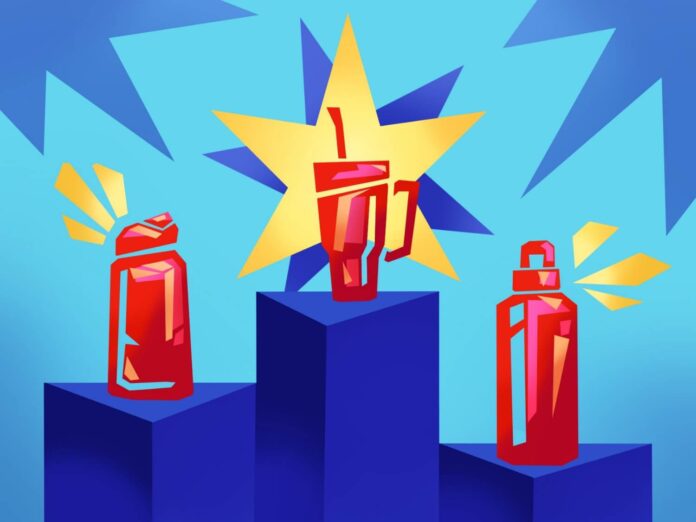When I first walked through Occidental during O-Week, I couldn’t help but notice the pastel-colored water bottles tucked into backpack side pockets, scattered across library tables and abandoned in the lost and found. Even my social media feeds were flooded with them: a spectrum of brightly colored vessels that seemed to define campus life.
I looked down at my own brand-new bright orange bottle, tracing a finger over Oswald’s face, and thought: ‘Maybe I should get a new one.’ Moments later, I was online, falling down a rabbit hole of colorways, customizable lids and limited editions. But after the initial urge to splurge faded, I began to question why I felt the need to buy another bottle — one I clearly did not need.
I told myself it was an investment, a way to quench my thirst for sustainability. Yet the irony was difficult to ignore. The entire point of a reusable water bottle is to reuse it.
Over time, reusable bottles have become less about function and more about form. What once symbolized sustainability has evolved into a marker of identity, an example of symbolic consumption in which people use products and brands to express who they are or aspire to be. The rise of endless customization reinforces this idea, transforming bottles from practical objects into tools for self-expression.
As I settled into campus life, I began to notice how quickly a simple object could define social circles. At the gym, matching Stanley cups clustered near the ellipticals and in the library, Owalas formed a quiet army beside open laptops. Carrying the “right” bottle didn’t just keep you hydrated; it seemed to communicate that you cared, that you belonged. It was as if a shared symbol of sustainability had become a password into a certain kind of community.
Viewed through Maslow’s hierarchy of needs, water bottles have moved beyond fulfilling a basic physiological function. They now operate within the realm of belonging and self-actualization, helping individuals fit in while still maintaining a sense of uniqueness. The desire to own the same trending bottle as everyone else, but in a distinct color or finish, reflects a larger truth about consumer culture: even the most ordinary items have become symbols of social identity and value.
This cultural fixation is not new. The modern obsession with reusable bottles traces back to the late 2010s, when Hydro Flasks became an emblem of the “VSCO girl” aesthetic, a curation of environmental awareness. What began as a niche sustainability effort evolved into a global phenomenon powered by influencer marketing. A product designed to reduce waste paradoxically became one of the most sought-after consumer items online.
Manufactured scarcity strengthens this dynamic. “Limited-edition” releases — such as rare Stanley cups — create urgency and exclusivity, turning reusable bottles into collectibles rather than long-term tools. This shift reveals an underlying contradiction. Trends that claim to promote sustainability often encourage overconsumption instead. Producing stainless steel bottles also requires significant amounts of water and energy, which raises an important question: if we continue to buy new bottles, are we truly conserving resources, or simply consuming them in a different form?
This phenomenon also echoes Thorstein Veblen’s idea of conspicuous consumption, in which individuals display wealth — or, in this case, virtue — through visible goods. The modern consumer no longer flaunts luxury alone but moral awareness. A pastel bottle embossed with a sustainability logo signals not only taste but values, turning ethics itself into a kind of social currency. In a world that commodifies even minimalism, sustainability becomes another aesthetic — an identity we perform rather than a practice we live.
Advocates of the water bottle trend might counter that its popularity promotes healthier habits. Hydration is vital to both physical and cognitive well-being, and the cultural emphasis on “drinking more water” aims to incorporate wellness into daily life. The association between water intake and glowing skin or mental clarity may motivate people to adopt beneficial routines. From this perspective, the trend expresses self-care more than consumerism.
However, that argument weakens when wellness itself becomes a product. When the pursuit of health depends on purchasing the right products, the practice of self-care begins to resemble the consumerism it seeks to resist. The reusable water bottle thus becomes more than a vessel for hydration; it becomes a vessel for aspiration, holding our desires to appear healthy, ethical and socially conscious, even when those desires conflict.
The cycle of buying to feel sustainable ultimately reflects a deeper cultural challenge: the substitution of consumption in place of action. Companies urge us to “vote with our wallets” rather than question the systems that demand constant purchasing. True sustainability requires restraint, not replacement — a willingness to keep using what we already have, even when it’s no longer trendy.
Ultimately, the cultural fixation on reusable bottles exposes a broader paradox within modern sustainability. Our attempts to live responsibly often rely on the same consumption-driven systems that create environmental harm. Whether motivated by aesthetics, wellness or eco-consciousness, the act of buying yet another water bottle reveals a tension between ethics and identity, between doing good and looking good while doing it.
The reusable bottle is a perfect emblem of our era: an object that allows us to feel ethical while participating in the very patterns we critique. It represents a generation caught between awareness and action, between wanting to change the world and scrolling to find next drop.
My orange bottle still sits on my desk, dented and loud against a sea of muted pastels. It doesn’t match, but maybe that’s the point. In a culture that sells individuality by the ounce, keeping the same bottle might be the most original thing I can do.
Contact Samhita Krishnan at krishnan@oxy.edu
![]()



































